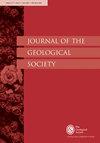新特提斯人的早期历史记录在克罗地亚西北部的蛇绿时期
IF 3
3区 地球科学
Q2 GEOSCIENCES, MULTIDISCIPLINARY
引用次数: 0
摘要
克罗地亚西北部蛇绿岩暴露归因于西瓦尔达蛇绿岩单元,并被解释为来自新特提斯的Meliata-Maliac-Vardar分支。研究了Ivanščica山蛇绿岩浆岩的岩石学和地球化学特征,并对其伴生的海相沉积岩进行了放射虫测年。所分析的喷流基性岩为化学上均匀的亚碱性高钛块状拉斑玄武岩,其特征是富E-MORB的典型成分。这些玄武岩形成于e - morb型非俯冲大地构造背景,与原始与衰竭地幔之间的富集地幔源过渡的部分熔融相适应,约占9% ~ 11%。这反映了海洋原壳形成的初始演替和海洋扩张的开始。与玄武岩相关的燧石岩和页岩演替中的放射虫表明,在晚安尼西世到早拉底世的早期海底扩张时期,海底扩张一直持续到朗哥巴第世。所获得的数据与报道的被解释为来自西瓦尔达蛇绿岩单元的三叠纪新特提斯壳残余的块体相关联,并进一步证实了它们来自亚德里亚微板块以东的单一海洋盆地的共同起源。专题收藏:这篇文章是蛇绿岩、杂色岩和蓝片岩收藏的一部分,可在https://www.lyellcollection.org/topic/collections/ophiolites-melanges-and-blueschists上找到本文章由计算机程序翻译,如有差异,请以英文原文为准。
The early history of the Neotethys archived in the ophiolitic mélange of northwestern Croatia
Ophiolite exposures in NW Croatia have been attributed to the Western Vardar Ophiolitic Unit and interpreted as derived from the Meliata-Maliac-Vardar branch of the Neotethys. Blocks within the ophiolitic mélange on Mt. Ivanščica were investigated for petrological and geochemical characteristics of effusive rocks and radiolarian dating of associated pelagic sedimentary rocks. Analysed effusive basic rocks represent chemographically uniform sub-alkaline high-Ti massive tholeiitic basalts characterized by an enriched composition typical of E-MORB. These basalts are compatible with approximately 9 to 11% of partial melting of an enriched mantle source transitional between primitive and depleted MORB-type mantle and are formed in the non-subduction geotectonic setting of E-MORB-type. This reflects an initial succession of oceanic protocrust formation and the onset of ocean spreading. Radiolarians from chert and shale succession associated with basalts indicate a Late Anisian to Early Ladinian age of the initial ocean floor spreading, which continued into the Langobardian. Obtained data are correlative with reported blocks interpreted as remnants of the Triassic Neotethys crust from the ophiolitic mélange of the Western Vardar Ophiolitic Unit and further reaffirm common origin from a single ocean basin located east of the Adria microplate. Thematic collection: This article is part of the Ophiolites, melanges and blueschists collection available at: https://www.lyellcollection.org/topic/collections/ophiolites-melanges-and-blueschists
求助全文
通过发布文献求助,成功后即可免费获取论文全文。
去求助
来源期刊

Journal of the Geological Society
地学-地球科学综合
CiteScore
6.00
自引率
3.70%
发文量
68
审稿时长
6-12 weeks
期刊介绍:
Journal of the Geological Society (JGS) is owned and published by the Geological Society of London.
JGS publishes topical, high-quality recent research across the full range of Earth Sciences. Papers are interdisciplinary in nature and emphasize the development of an understanding of fundamental geological processes. Broad interest articles that refer to regional studies, but which extend beyond their geographical context are also welcomed.
Each year JGS presents the ‘JGS Early Career Award'' for papers published in the journal, which rewards the writing of well-written, exciting papers from early career geologists.
The journal publishes research and invited review articles, discussion papers and thematic sets.
 求助内容:
求助内容: 应助结果提醒方式:
应助结果提醒方式:


